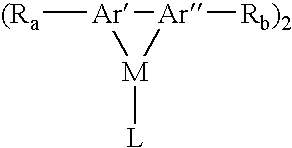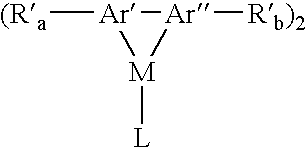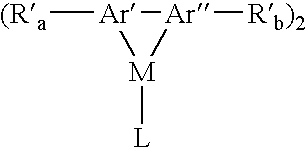Aromatic monomer-and conjugated polymer-metal complexes
a monomer and metal complex technology, applied in the field of aromatic polymermetal complexes, can solve the problems of unpredictability of the properties of the final polymer, incomplete reaction of pendant ligands with metal complexing reagents,
- Summary
- Abstract
- Description
- Claims
- Application Information
AI Technical Summary
Benefits of technology
Problems solved by technology
Method used
Image
Examples
example 1
Preparation of Iridium (III) bis{2-[4′-(4″-bromophenoxy)phenyl]pyridinato-N,C2′}(acetylacetonate
A. Preparation of 2-(4′-Phenoxy)phenylpyridine
4-Phenoxyphenylboronic acid (10.7 g, 0.05 mol) and 2-bromopyridine (11.58 g, 0.075 mol) were dissolved in 250 mL of THF followd by addition of 2M NaCO3 (60 mL) and tetrakis(triphenylphosphine)palladium (0) (0.29 g). The reaction mixture was boiled at reflux overnight and then transferred into a separation funnel to remove the aqueous layer. The organic layer was removed in vacuo and the residue was eluted through a silica gel column, first with 1:1 chloroform and hexane mixture and then with pure chloroform to afford a pale yellow oil. HPLC showed a purity of 99.5%. GCMS: M+=247.
B. Preparation of 2-[4′-(4″-Bromophenoxy)phenyl]pyridine
A solution of N-bromosuccinimide (NBS, 3.95 g, 22.2 mmol) in DMF (10 mL) was added to a solution of 2-(4′-Phenoxy)phenylpyridine (5.8 g, 23.4 mmol) in DMF (100 mL) at room temperature. The reaction mixture...
example 2
Preparation of a Co-polymer Containing Iridium (III) bis[2-(4′-phenoxyphenyl)pyridinato-N,C2′](acetylacetonate)
Tetrakis(triphenylphosphine)palladium(0) (5 mg) and 2M aqueous sodium carbonate solution (11 mL) were added under nitrogen to a stirred mixture of 9,9-di(1-octyl)fluorene-2,7-diboronic acid ethylene glycol ester (2.149 g, 4.04 mmol), 2,7-dibromo-9,9-di(1-octyl)fluorene (1.647 g, 3.00 mmol), 3,7-dibromo-N-(4-n-butyl)-phenyl-phenoxazine (0.190 g, 0.40 mmol), N,N′-(di(bromophenyl)-N,N′-di(9,9-dibutyl)fluorene-1,4-phenylenediamine (0.390 g, 0.40 mmol), iridium (III) bis{2-[4′-(4″-bromophenoxy)phenyl]pyridinato-N,C2′}(acetylacetonate) (0.188 g, 0.20 mmol), and Aliquat 336 (0.75 g) phase transfer catalyst in toluene (50 mL). The reaction mixture was stirred at 101° C. under nitrogen for 16 h. Then, 9,9-di(1-octyl)fluorene-2,7-diboronic acid ethylene glycol ester (20 mg) was added and the polymerization was continued under the same conditions for another 3 h. Bromobenzene (0.15 ...
example 3
Iridium (III) bis[2-(4′-phenoxyphenyl)pyridinato-N,C2′](acetylacetonate) Containing a Fluorene copolymer II
The procedure described in Example 2 was followed except that N,N-diphenyl-3,5-dibromoaniline (0.3248 g, 0.80 mmol) was used instead of dibromo-N-(4-n-butyl)-phenyl-phenoxazine and N,N′-(di(bromophenyl)-N,N′-di(9,9-dibutyl)fluorene-1,4-phenylenediamine (0.390 g, 0.40 mmol); the copolymer II was prepared in the yield of 2.13 g.
PUM
| Property | Measurement | Unit |
|---|---|---|
| structure | aaaaa | aaaaa |
| β-diketonate | aaaaa | aaaaa |
| electroluminescent | aaaaa | aaaaa |
Abstract
Description
Claims
Application Information
 Login to View More
Login to View More - R&D
- Intellectual Property
- Life Sciences
- Materials
- Tech Scout
- Unparalleled Data Quality
- Higher Quality Content
- 60% Fewer Hallucinations
Browse by: Latest US Patents, China's latest patents, Technical Efficacy Thesaurus, Application Domain, Technology Topic, Popular Technical Reports.
© 2025 PatSnap. All rights reserved.Legal|Privacy policy|Modern Slavery Act Transparency Statement|Sitemap|About US| Contact US: help@patsnap.com



